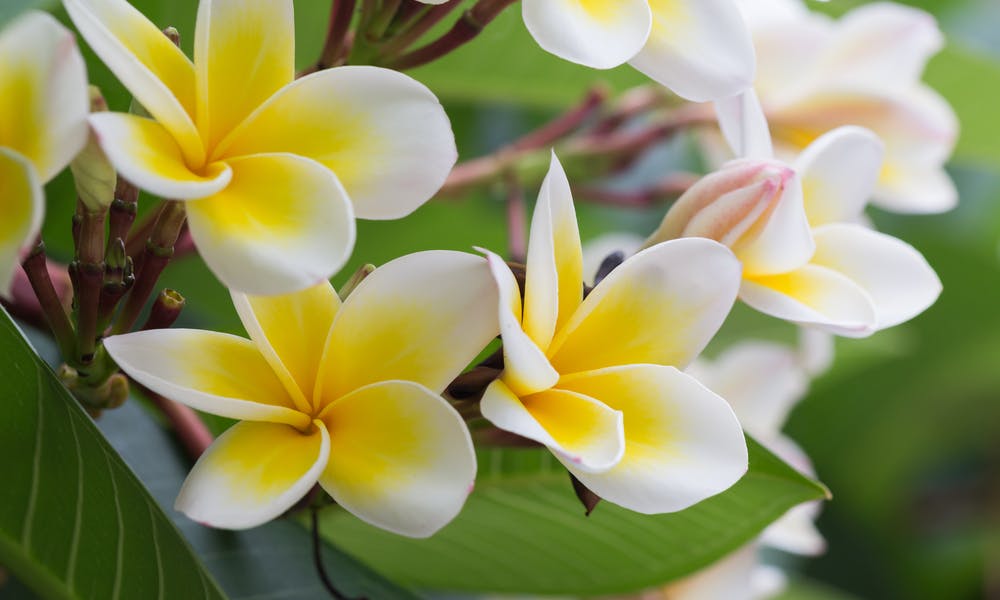MENU
The Plumeria Flower

The Plumeria flower, popularized throughout the world for its use in traditional Hawaiian leis, is a gorgeous, fragrant plant found in many areas. Its showy petals and gnarled branches evoke images of cheerful parties and beautiful islands. Let’s jump in and explore the many myths and legends associated with the plumeria, as well as all the fun little details needed to make this flower a part of your life.
Keep reading to find out:
- The History of the Plumeria Flower
- Plumeria Details
- Symbolism in Ancient Mayan and Aztec Culture
- Use in Hawaiian Culture
- Symbolism in Asia
- How the Plumeria is a Trickster
- How to Raise your Own Plumeria
The History of the Plumeria Flower
The plumeria, or Frangipani, is a flowering plant of the family Apocynaceae. There are varying accounts of how many species exist, with some sources citing eight to 10 with others saying as many as 300 species within the plumeria genus. It received its name after French native Charles Plumier, an avid explorer who visited the new world many times to document the plant and animal species there. The name Frangipani is thought to come from an Italian nobleman by the same name who created a perfume from the flower to scent gloves. Native to central and South America, they are commonly found in Mexico and Brazil. They have been normalized in areas of Australia, North America, and many parts of Asia. They have become overly abundant in Hawaii as well, due to their cultural use in leis. It is the national flower of Nicaragua.
Plumeria Details
A deciduous plant, plumeria trees and shrubs tend to be rather small, growing around 5 to 6 meters in height generally, although they grow can quite wide, reaching almost the same width as their height. The bark of the tree is unusual, with a greyish and scaly appearance. The flowers grow in clusters, with as many as 60 flowers growing per tree, each with distinctly waxy petals. The plumeria produces a milky white sap that is quite poisonous. A gorgeous flower, the leaves generally have two different colors, with the exterior of the flower being one and the center part being another. They can be found in a variety of colors, with the most common ranging from crimson to orange, with white, and yellow being found as well. Interestingly, the plumeria is incredibly fire resistant, requiring massive temperatures before being at risk.
Symbolism in Ancient Mayan and Aztec Culture
With wall carvings being found as old as two millennia ago, the plumeria flower had deep meaning for these ancient cultures. During the pinnacle of Aztec culture, the flowers symbolized status and were worn by the elites of the society. The plumeria was associated with the deities of life and fertility and was used to represent female sexuality.
Use in Hawaiian Culture
In many of the Pacific islands, most notably Hawaii, the plumeria species are used in the making of leis. Leis are wreaths of flowers typically worn around the neck or head and are commonly given to new arrivals to the country or to those leaving as a symbol of affection. In modern times, women wear the plumeria flower in their hair to show whether they are single and searching for a partner or in a relationship, with the right ear designating a woman’s search for a partner and the left a sign that she is taken. The plumeria is associated with positivity and cheerfulness in Hawaii.
Symbolism in Asia
In areas of the Philippines, Malaysia, and Indonesia, the plumeria is often buried in cemeteries to appease and protect the spirits residing there. It is commonly used in Indian incense as well as in Hindu offerings to the temples. Hindu women place the flower in their hair on their wedding day as a symbol of their loyalty to their husbands. In the Buddhist tradition, the plumeria flower was associated with concepts of immortality, with countries such as Laos, who have named it their national flower, considering them so sacred that they are placed outside every single Buddhist temple. In many areas of Asia, the plumeria is thought to symbolize dedication and devotion.
How the Plumeria Is a Trickster
Unlike many other plants, the plumeria does not produce nectar. This poses a problem for it, as it requires aid from insects to spread its pollen. To get around this, the plumeria has become adept at tricking sphinx moths into getting its pollen around. The plumeria produces a very potent fragrance at night that draws in the moths, who after being covered with the pollen, go on to be tricked again by the next plumeria flower and help it spread its pollen around.
How to Raise Your Own Plumeria
Due to its tropical roots, the plumeria flower requires well-drained soil, and a large amount of sunlight, ideally six hours or more for good health. An easy fix for those whose climate tends to get a bit colder is to plant them outdoors in containers, then bring them indoors until the weather warms up later on. A good perlite or cactus mix can be used when potting the plants. While growing, it is ideal to fertilize them every two to three weeks. Watering them every week or so is fine, so long as the soil is given time to dry out between watering’s. They require occasional pruning’s but do not do well if pruning is too extensive.
Fun times with the Plumeria Flower
Whether it is hanging off someone’s neck while they stroll through gorgeous Polynesian islands or being burnt in sacred ceremonies in ancient India, the plumeria flower has made a place for itself in cultures around the world. This delicate flower can be the perfect companion to any garden or indoor abode that needs some beauty and positivity in its life.

